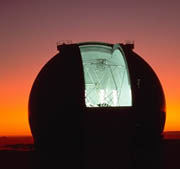26 June 1998
New Planet Discovered Just A Stone's Throw Away
 Astronomers have discovered a massive new planet - right in our own back garden. Orbiting a star just fifteen light years from Earth, it is 1.6 times as massive as Jupiter and looks to have some intriguing properties.
Astronomers have discovered a massive new planet - right in our own back garden. Orbiting a star just fifteen light years from Earth, it is 1.6 times as massive as Jupiter and looks to have some intriguing properties.
The planet was first discovered by Geoffrey Marcy and colleagues from San Francisco State University and the University of California, Berkeley. Using telescopes at Lick Observatory and Hawaii's Keck telescope atop Mauna Kea (pictured), the team were alerted by a telltale wobble in the motion of star Gliese 876.
Details of the finding will be reported in the June 27 issue of Science News. Science à GoGo has been given a sneak preview, and can reveal that the planet is the first to be discovered around a low-mass star. At just a third the mass of the Sun, Gliese 876 confounds previous theories about planetary systems. Until now, astronomers have tended to look for new planets around stars similar to our own.
According to the Science News report, the planet is closer to its star than Mercury is to the Sun, and takes 61 days to orbit. Its surface is thought to be gaseous, with temperatures around -75 degrees Celsius. Though below freezing point, liquid water may exist in warmer layers below the surface.
As far as possible life is concerned, Marcy and his team are cautious. "We shouldn't go into a feeding frenzy about this," he says, but speculates that solid moons around the planet - if they exist - might harbour better prospects.
Picture courtesy of W.M. Keck Observatory
